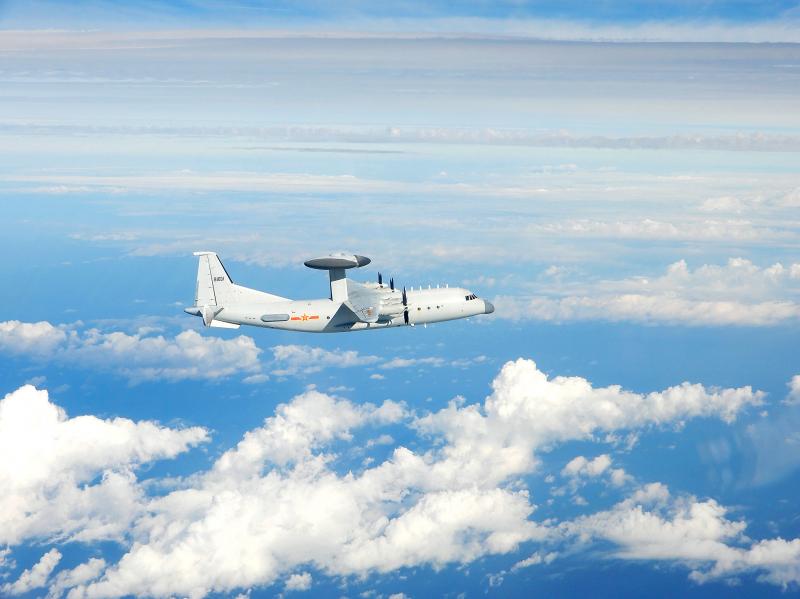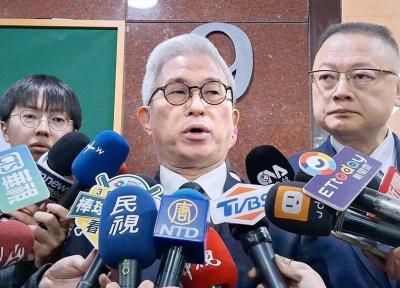Beijing’s two largest air sorties into Taiwan’s southwest air defense identification zone (ADIZ) last month were more directed at the new administration of US President Joe Biden than Taiwan, an analyst said.
Institute for National Defense and Security Research assistant research fellow Jeremy Hung (洪子傑) made the comments in a research paper published on the institute’s Web site on Wednesday.
Last year, the Chinese People’s Liberation Army (PLA) sent aircraft into the airspace between Taiwan and the Pratas Islands (Dongsha Islands, 東沙群島) in the South China Sea on at least 100 days, the Ministry of National Defense said.

Photo courtesy of the Ministry of National Defense
Taiwan considers the airspace above strategic waters connecting the Taiwan Strait and the Bashi Channel to the South China Sea part of its ADIZ.
Chinese military planes flew into the zone 26 out of the first 30 days of this year, ministry records showed.
However, the two largest intrusions came on Jan. 23 and 24, when the PLA sent 13 and 15 military planes, including bombers and fighter jets, respectively, into the area.
The ministry began publicizing the Chinese incursions in mid-September last year.
Hung said the two largest incursions came shortly after Biden took office
The mode of “harassment” differed from previous intrusions, when the PLA mostly deployed one or two low-speed spy planes, which are not considered as provocative as fighter jets, Hung said.
However, the two incursions last month were “less intimidating,” as they took place in airspace southwest of Taiwan rather than in the middle of the Taiwan Strait, he added.
The PLA has previously sent aircraft across the median line of the Strait, such as when Beijing believes developments involving Taiwan breach its “one China” principle, he said.
The two incidents last month were Beijing’s response to Washington inviting Representative to the US Hsiao Bi-khim (蕭美琴) to Biden’s inauguration, and a Jan. 23 statement by the US Department of State urging China to stop intimidating Taiwan, Hung said.
Although the two incidents can still be viewed as part of Beijing’s continued coercion of Taiwan, sending a message to the Biden administration, as well as proving PLA training, might be Beijing’s main objectives, he said.
From a political viewpoint, Beijing might want to pressure the new US government into bilateral dialogue, he said.
From a military perspective, the PLA might also want to test and hone its combat skills, as the USS Theodore Roosevelt and its battle group transited the Bashi Channel into the South China Sea on Jan. 23, he added.
Intrusions by warplanes are a “double-edged sword,” Huang said.
While Beijing moves to increase its military presence in the region, such action gives the US legitimate reasons to sell arms to Taiwan, he added.

Taiwan is to commence mass production of the Tien Kung (天弓, “Sky Bow”) III, IV and V missiles by the second quarter of this year if the legislature approves the government’s NT$1.25 trillion (US$39.78 billion) special defense budget, an official said yesterday. Commenting on condition of anonymity, a defense official with knowledge of the matter said that the advanced systems are expected to provide crucial capabilities against ballistic and cruise missiles for the proposed “T-Dome,” an advanced, multi-layered air defense network. The Tien Kung III is an air defense missile with a maximum interception altitude of 35km. The Tien Kung IV and V

The disruption of 941 flights in and out of Taiwan due to China’s large-scale military exercises was no accident, but rather the result of a “quasi-blockade” used to simulate creating the air and sea routes needed for an amphibious landing, a military expert said. The disruptions occurred on Tuesday and lasted about 10 hours as China conducted live-fire drills in the Taiwan Strait. The Civil Aviation Administration (CAA) said the exercises affected 857 international flights and 84 domestic flights, affecting more than 100,000 travelers. Su Tzu-yun (蘇紫雲), a research fellow at the government-sponsored Institute for National Defense and Security Research, said the air

A strong continental cold air mass is to bring pollutants to Taiwan from tomorrow, the Ministry of Environment said today, as it issued an “orange” air quality alert for most of the country. All of Taiwan except for Hualien and Taitung counties is to be under an “orange” air quality alert tomorrow, indicating air quality that is unhealthy for sensitive groups. In China, areas from Shandong to Shanghai have been enveloped in haze since Saturday, the ministry said in a news release. Yesterday, hourly concentrations of PM2.5 in these areas ranged from 65 to 160 micrograms per cubic meter (mg/m³), and pollutants were

Taiwan’s armed forces have established response protocols for a wide range of sudden contingencies, including the “Wan Chun Plan” to protect the head of state, the Ministry of Defense (MND) said today. After US President Donald Trump on Saturday launched a series of airstrikes in Venezuela and kidnapped Venezuelan President Nicolas Maduro, concerns have been raised as to whether China would launch a similar “decapitation strike” on Taiwan. The armed forces regularly coordinate with relevant agencies and practice drills to ensure preparedness for a wide range of scenarios, Vice Minister of National Defense Hsu Szu-chien (徐斯儉) told reporters before a